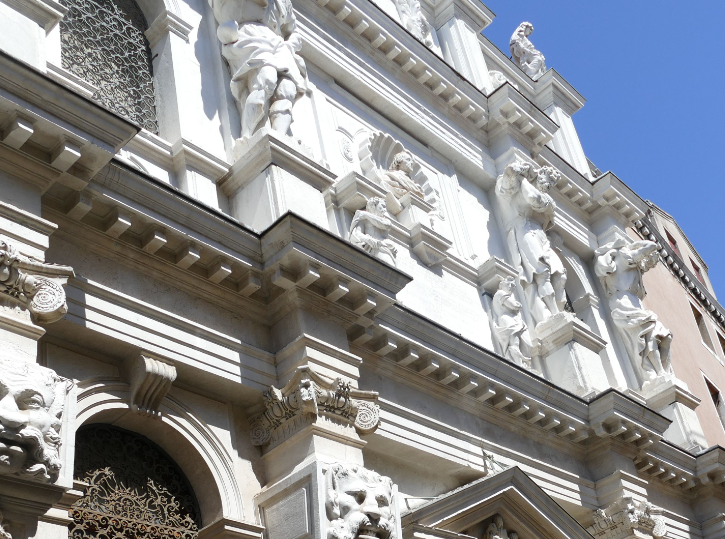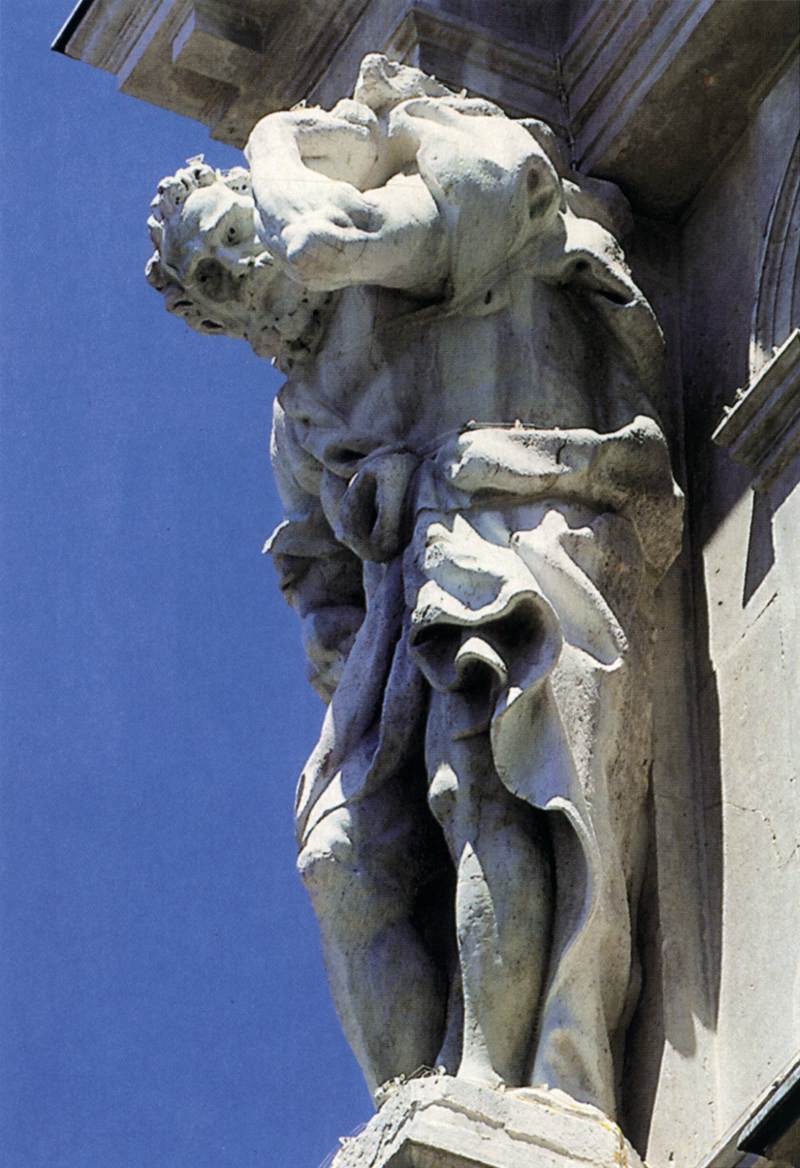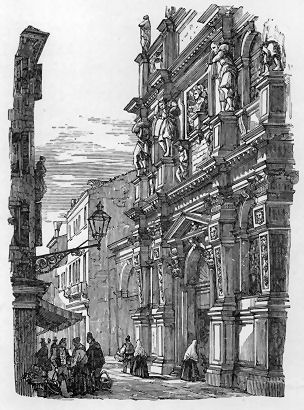Impression issue de Maquetland.com Le monde de la maquette | http://www.maquetland.com/article-phototheque/13934-venise-chiesa-dell-ospedaletto-o-santa-maria-dei-derelitti
 Venise Chiesa dell'Ospedaletto o Santa Maria dei Derelitti
Venise Chiesa dell'Ospedaletto o Santa Maria dei Derelitti

Venise Chiesa dell'Ospedaletto o Santa Maria dei Derelitti
English Translation
Historique Voir ICI
History Click HERE
Cette église est connue sous le nom de L 'Ospedaletto (petit hôpital) depuis le 17e siècle car elle faisait partie du plus petit des quatre hôpitaux vénitiens, créé pour prendre soin des orphelins, des sans-abri pauvres et des personnes âgées. Fondée par une congrégation laïque en 1528, les travaux sur l'église actuelle, construite pour remplacer la petite chapelle existante, ont commencé en 1575. Le plan d'origine fut dessiné par Palladio, mais en raison d'un manque de fonds, les travaux ont progressé lentement jusqu'en 1662 date à laquelle elle put être terminée suite à un important legs par le marchand Bartolomeo Cargnoni. Cela a accéléré les choses et agrandi les bâtiments, Antonio Sardi et son fils travaillant sur le bâtiment de l'hospice, avant qu'ils ne soient licenciés deux ans après un différend
.Baldaressa Longhena prend le relais en 1666 - la façade et l'intérieur sont son œuvre. Comme la Pietà de Vivaldi, Le complexe est devenu une maison de retraite en 1807 et appartient maintenant à l'IRE (un organisme public gérant des maisons pour personnes âgées et mères célibataires)
La façade
C 'est une facade dans le style baroque avec des atlantes ou telamon ici des pèlerins tenant l'église sur leurs épaules, des masques avec des oreilles d'âne et une profusion de saillies en général. On dit parfois qu'il a été inspiré par le monument contemporain de Pesaro dans le Frari avec ses
 |
énormes cariatides. Au milieu de la rangée de atlantes trouve une coquille avec un buste de Bartolomeo Cargnoni, le bienfaiteur.
 |
Intérieur
la nef est unique et elle possède un plafond toit plat qui a été récemment restauré. Trois autels tous de Longhena sont présents . Le maître-autel a été initialement conçu par Palladio, mais Longhena l'a démantelé et reconstruit, et le retable Le Couronnement de la Vierge de Damiano Mazza, un élève de Titien, a dû être ajusté pour s'adapter. Les fresques du plafond ont été réalisées en 1907 par Giuseppe Cherubini.
On y trouve aussi quelques peintures du XVIIe et du début du XVIIIe siècle. Une de Giambattista Tiepolo (Le sacrifice de Barthélemy - une des premières œuvres, peinte à l'âge de 20 ans). Dans la salle de musique récemment restaurée de l'hospice se trouvent des fresques au plafond de Jacopo Guarana. Également des fresques architecturales en trompe-l'œil sur les murs d'Antonio Mengozzi Colonna montrant les filles de l'hospice donnajnt un spectacle, l'une nourrissant un lévrieravec un beignet.
pour Ruskin cette église est l'exemple le plus monstrueux de la renaissance grotesque qu'il y a à Venise; les sculptures sur sa façade représentant des masses de personnages malades et des fruits gonflés. Il vaut presque la peine de consacrer une heure à l'examen subséquent de cinq bâtiments, illustrant la dernière dégradation de la Renaissance. Son Moise est le plus maladroit, Santa Maria Zobenigo le plus impie, St. Eustachio le plus ridicule, l'Ospedaletto le plus monstrueux et la tête à Santa Maria Formosa le plus mal.
History
The church has been known as L' Ospedaletto (small hospital) since the 17th century because it was part of the smallest of the four Venetian hospitals, created to care for orphans, the homeless poor and the elderly. Founded by a lay congregation in 1528, work on the current church, built to replace the existing small chapel, began in 1575. The original plan was by Palladio, but due to a lack of funds work progressed slowly until 1662 and a large bequest by the merchant Bartolomeo Cargnoni. This sped things up and enlarged the buildings, with Antonio Sardi and his son working on the hospice building, before they were dismissed after two years following a dispute. Longhena took over in 1666 - the façade and the interior are his work. Like Vivaldi's Pietà this church/hospice was famous for its accomplished female musicians. The complex became an old-people's home in 1807 and is now owned by IRE (a public body running homes for the elderly and single mothers) whose offices are next door.
The façade
Another heavy Ruskin-baiting (see below) baroque affair, with telamons (beefy pilgrims) holding the church up on their shoulders, masks with donkey ears, and a profusion of protrusions generally. It is sometimes said to have been inspired by the contemporary Pesaro Monument in the Frari with its huge caryatids. In the middle of the row of telamons is a shell with a bust of Bartolomeo Cargnoni, the benefactor.
Interior
A single aisle-less space with a flat roof. Recently restored. Three altars on each side, all by Longhena. The high altar was originally designed by Palladio, but Longhena dismantled it and rebuilt, and the altarpiece The Coronation of the Virgin by Damiano Mazza, a pupil of Titian, had to be adjusted to fit. The ceiling frescoes were done in 1907 by Giuseppe Cherubini.
Art highlights
Some good paintings of the 17th and early 18th centuries. One by Giambattista Tiepolo (The Sacrifice of Bartholomew - an early work, painted when he was 20). In the recently restored music room of the hospice are ceiling frescoes by Jacopo Guarana. Also trompe l'oeil architectural frescoes on the walls by Antonio Mengozzi Colonna showing the hospice's girls performing, with one feeding a greyhound a doughnut. (A visit to the music room seems to involve paying €2 and being led down labyrinthine corridors.)
Ruskin said
The most monstrous example of the Grotesque renaissance which there is in Venice; the sculptures on its façade representing masses of diseased figures and swollen fruit.
It is almost worth devoting an hour to the successive examination of five buildings, as illustrative of the last degradation of the Renaissance. San Moise is the most clumsy, Santa Maria Zobenigo the most impious, St. Eustachio the most ridiculous, the Ospedaletto the most monstrous, and the head at Santa Maria Formosa the most foul.
Tall Tiepolo tale
Whilst painting the spandrels in the church (as mentioned above) the young Tiepolo met Cecilia, the sister of Antonio and Francesco Guardi. She had been placed in the care of the Ospedaletto by her widowed and impoverished mother at the age of 15. This was a bit old but she was admitted, and placed in the choir, due to the excellence of her soprano voice. The artist and Cecilia eloped in 1719. She appears in many of his paintings of the 1720s and during their long marriage she gave birth to the artists Giandomenico and Lorenzo.
Update 05/2015 The above meeting and eloping story may not be entirely true, it seems. My lack of academic rigor means that I have now no memory or note of my source for it. A novel of the life of Tiepolo, Merchants of Light by Marta Maretich, has them meeting at an exhibition outside San Rocco, but the author invented this. She says she never came across my version of their meeting in all her years of research





